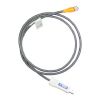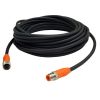Vaisala WSP152 Surge Protector
Features
- Designed to protect the USB connection of a PCconnected to the Vaisala WXT510 or WMT52
- Excellent three-stage, transient surge protection
- Tolerates up to 10 kA surge currrents
- Free ground shipping
- Expedited repair and warranty service
- Lifetime technical support
- More
Overview
The Vaisala WSP152 Surge Protector is a compact transient overvoltage suppressor designed for the protection of the USB connection of a PC connected to the Vaisala WXT520 or WMT52. The WSP152 is designed to protect the host PC against surges entering through the USB port. Please note that the USB connection of a PC is for indoor use only.
Mechanics
The Vaisala WSP152 Surge Protector offers three-stage protection against surge currents up to 10 kA that may enter through the USB cable or the port. The WSP152 has four channels, two of which are dedicated to power lines and two for data lines. Each channel uses a three-stage protection scheme as follows: first, there are discharge tubes, then voltage-dependent resistors (VDR), and finally, transient zener diodes. Between each stage, there are either series inductors or resistors.
Both differential and common mode protection is provided for each channel: across the wire pairs, against the operating voltage ground, and against the earth. The WSP152 also includes noise filtering against HF and RF interference.
Applications
Vaisala recommends using the WSP152 when USB cables are used for permanent connections. The surge protector is always recommended when there is an elevated risk of lightning strikes.
In The News
Three Decades of Research at Acton Lake
A multi-disciplinary team at Miami University, Ohio, has been studying the environmental change at Acton Lake for over three decades. Using three different NexSens buoys over this time, the team has an incredible archive of data that is helping build a picture of Acton’s past, present, and future. Until recently, a NexSens CB-50 buoy was used alongside other environmental monitoring at Acton Lake. In May 2025, the Miami team deployed a new XB-200 buoy , future-proofing their ongoing monitoring using real-time buoy systems. Acton Lake, a small hypereutrophic reservoir in southwest Ohio, covers 2.4km² and has a maximum depth of about 8m. The dam was built in 1956, and the lake has a large agricultural watershed.
Read MoreSource Water Monitoring in Albany, New York: Tracing Water Quality throughout Tributaries
Thousands of US cities pull their drinking water from natural source waters like reservoirs, rivers, and streams, making overall watershed health a key consideration for water providers. In Albany, New York, the Albany Department of Water and Water Supply delivers drinking water to over 100,000 residents as well as monitors and manages the larger drinking water supply watershed. Hannah Doherty, Environmental Specialist at the Albany Department of Water and Water Supply , spends her days working with a small team to monitor the drinking supply and the connected water bodies. Doherty explains, “We’re the first to encounter the water that ends up being the drinking water.
Read MoreWildfire Prevention in the Sierra Nevada Region with the Yuba Watershed Institute
Though recent wildfires have sparked new conversations about wildfire management and response, groups like the Yuba Watershed Institute have been monitoring the forests and water resources of the Sierra Nevada region for decades, managing approximately 5,000 acres of land with the Bureau of Land Management (BLM) and about 7,000 acres in private land partnerships. The goal of the Institute is to work with local communities and land agencies to improve watershed and forestry management through informed practices and public outreach. The goals of the Yuba Watershed Institute are three-fold: Improve the ability of fire suppression agencies like the California Department of Forestry and Fire Protection ( CAL FIRE ) and the US Forest Service.
Read More










